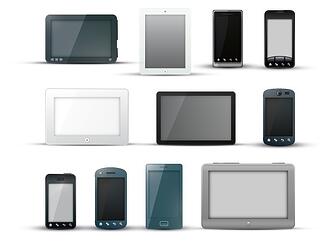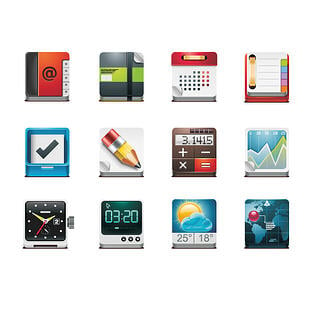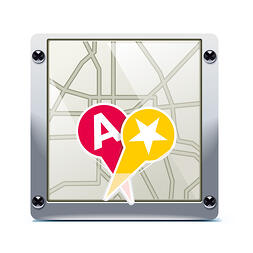Mobile devices, to which more than 75 percent of the world now have access (World Bank, 2012), are quickly becoming the device of choice for both personal and business use. In this context, the term mLearning is gaining more importance and has become a point of interest for everyone in the training industry. Whether if you’re in the eLearning industry or not, the term “mLearning” is a fairly new strategy and thus the terminology associated with mLearning can be a bit confusing.
Half the challenge to mastering any new topic is understanding the acronyms and terms so this post should be a great way for newbies to start getting familiar with the topic. Here we will be explaining the most common defintions-- easily and very graphically.
 For starters let’s define Mobile Device:
For starters let’s define Mobile Device:
There are different opinions about what is or is not a mobile device. In general terms, a mobile device can refer to any portable device including smartphones, laptops, tablets, game consoles, and personal media players.
mLearning:
The concept of mLearning or mobile learning is evolving, so there are many definitions, however, we can say that mLearning refers to the use of portable or mobile technologies to facilitate, support, enhance and extend the scope of teaching and learning. Superficially, it appears from the outside to be learning via mobile devices. Some experts have define it as “highly situated, personal, collaborative and long term; in other words, truly learner-centred learning”. Others have simplified it into three words: "learning in context".
Look for blog posts, white papers, and other resources that could get you thinking about what’s out there in mobile learning. We specially recommend visiting these links:
- Top 50 Mobile Learning Resources.
- 61 tips on mLearning: Making Learning Mobile. A free ebook by The eLearning Guild.
- Everything about Mobile Learning and Mobile Technologies. Our curated topic at scoop.it. Here you can find dialy news, articles, statistics and basically everything you want to know about Mobile Learning.
- Mobile Learning Guide by Kineo. You can view part's 1, 2 and 3 of the guide by clicking this link.
- 10 Reasons Why Pay Attention to Mobile Learning (Blogpost + Slideshow.)
 Mobile Application:
Mobile Application:
Most commonly known as an app, is a type of application software designed to run on a mobile device, such as a smartphone or tablet. The most popular smartphone platforms that support mobile learning apps are Android, Symbian, Java ME, Windows Mobile and Palm. For example, Harvard Business School (HBS) created an app for enrolled course participants. This app allowed access to library resources, audio and video case studies as well as course schedules, announcements and maps.
HTML5
To say it in as few words as possible, HTML5 is the last version of the HTML language. HTML stands for Hypertext Markup Language, and is the main tool used to build web pages (although it can be used for offline content as well.)
HTML5 is an emerging standard. Many features are still in process, some no longer exist and it is likely that some new features appear in the near future. What we must know is that HTML5 is rapidly evolving as the authoring language of choice for web applications – and the tool that enables “build it once; deploy it across all devices.” In the eLearning context, this means that with HTML5 you develop a course once, and you can deploy almost everywhere. You don’t need to create one version, in a specific language, for Windows, another for Mac, another one for iOS, and yet another for Android (and that’s only four of the myriad of platforms out there).
You can learn more about HTML5 in this recommended links:
- A Simple Explanation of HTML5.
- YouTube Video: What is HTML5?
- Infographic: The History of HTML5
- There are a lots of online resources for beginners, intermediates and experts. The W3 Schools, Treehouse, HTML5 Rocks are all good starting points.
- It’s a very good idea to follow some relevant people and organizations on Twitter, Facebook, or subscribe to their newsletters, when available. To name a few we’ve not already mentioned,Smashing Magazine, The WHATWG community, Chrome Dev Relations, and David Travis
 Responsive Design
Responsive Design
Responsive Design or adaptive design is one of the advantages enabled by HTML5. Luckily, developments in HTML5 mean we can now develop a single eLearning course which will work on many devices. Onscreen content automatically changes layout depending on the screen size and resolution it’s being displayed on. Layout re-arranges itself so the text remains the same size and the course still has an intuitive layout. Learners are able to access the same course on a range of devices and still get a great learning experience.
Watch this quick video to have a clearer idea of how this works.
 Geolocation
Geolocation
Geolocation is used to identify the geographic location of an object, usually a mobile phone or other device connected to the Internet. Although the location is not a basic element of eLearning at this time, is a great opportunity to be exploited, thus it allows placing content into a specific context, for example, you can deliver content according to the student's geographical position and make the learning process more efficient. Be careful, it can be used to make course content more personalized but not to make the course design depend on geolocation information being known.
Augmented or Just in Time Learning:
Popular term to describe the benefit of mobile learning’s accessibility. Augmented Learning refers to a learning method where information is made a available on demand. It’s “Instant on-the-job support or refresher training at the point of need”. It’s convenient, flexible and relevant, learning at the exact moment learning is required.
Bring Your Own Device (BYOD):
Bring Your Own Device’ or BYOD is a full-on phenomenon. It refers to an organization’s employees using their personal devices (usually Smartphones/Tablets) at the workplace to access company resources for business use. Companies are allowing employees to bring their own device for the potential cost savings, productivity increases and employee satisfaction.
Take a look at our BYOD Infographics board on Pinterest for shocking statistics, trends and benefits of this movement.
There are many more terms, some of which are more or less important than others. But the eight discussed here are the major ones, and should give you the leg up you need when you first get started with mLearning. We hope these definitions listed above will help you expand your mLearning vocabulary and make you look and feel like an expert!
What Terms Do You Feel Are Critical to a Mobile Learning Strategy?








